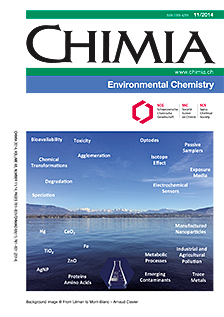The Use of Passive Samplers to Reveal Industrial and Agricultural Pollution Trends in Swiss Rivers
DOI:
https://doi.org/10.2533/chimia.2014.778Keywords:
Herbicides, Ldpe, Passive sampling, Pcb, PocisAbstract
This study shows the efficiency of passive sampling to reveal industrial and agricultural pollution trends. Two practical applications for nonpolar and polar contaminants are presented. Low-density polyethylene (LDPE) samplers were deployed for one year in the Venoge River (VD) to monitor indicator PCBs (iPCBs, IUPAC nos. 28, 52, 101, 138, 153 and 180). The results showed that the impact of PCB emissions into the river is higher in summer than in other seasons due to the low flow rate of the river during this period. Polar organic chemical integrative samplers (POCIS) were deployed for 4 months in the Sion-Riddes canal (VS) to investigate herbicides (terbuthylazine, diuron and linuron). Desisopropylatrazine-d5 (DIA-d5) was tested as a performance reference compound (PRC) to estimate aqueous concentration. The results showed an increase of water contamination due to the studied agricultural area. The maximal contamination was observed in April and corresponds to the period of herbicide application on the crops.Downloads
Published
2014-11-26
How to Cite
[1]
A. Schopfer, N. Estoppey, J. Omlin, R. Udrisard, P. Esseiva, L. F. de Alencastro, Chimia 2014, 68, 778, DOI: 10.2533/chimia.2014.778.
Issue
Section
Scientific Articles
License
Copyright (c) 2014 Swiss Chemical Society

This work is licensed under a Creative Commons Attribution-NonCommercial 4.0 International License.







